GameSpotting Prime
The GameSpot editors don their mysterious alien power suits, load up on rockets, and start hunting down those nasty space pirates.
In this, our latest episode of everyone's most favoritest video game editorial, the GameSpot editors don their mysterious alien power suits, load up on rockets, and start hunting down those nasty space pirates. Along the way, we make a new ally in mobile gaming guru Steve Palley and discover that The Chronicles of Riddick: Escape From Butcher Bay is way, way better than it probably should have been. If you think you have what it takes to be an intergalactic bounty hunter, er, GameSpotting contributor, check out the GuestSpotting FAQ.
Steve Palley/Associate Editor, Mobile Games
"Consoles and PCs aside, it's tough to argue with the sheer brute polygon-pushing power of the PSP, the elegance of the DS, and the encyclopedic library of the GBA."
Greg Kasavin/Executive Editor
"The Chronicles of Riddick is not just an incredible game--it's a fascinating textbook case, unlike anything I've ever seen happen before in the gaming industry."
Bob Colayco/Associate Editor
"Right now console shooters are falling far behind in scale compared to what the PC can offer."
Greg Mueller/Intern
"As the show closed and we left the convention center one last time, I chalked my first E3 up as a personal milestone, an affirmation, and an exciting glimpse of things to come."
Tyler Winegarner/Associate Producer, GameSpot Live
"Ultimately, we play games because there's something that's fun to interact with on the screen."
Ben Coello/Renegade
"Wanna know the mystical importance of Del Taco? Care to discover the awful secret behind R and R?"
Stephen Webster/GuestSpotter
"My hands hurt from the controller, my eyes were squinting from the onscreen frame-flicker, and I was not entertained."
Barnaby Van Gamenstein/GuestSpotter
If you're reading our thoughts on video games, then you probably think about video games a lot, too. So why not exorcise those demons by putting them down on paper? Read our GuestSpotting FAQ, and submit your column accordingly.
| Steve Palley Associate Editor, Mobile Games |
The Old Soft Cell
So, this column rounds out the first approximate month I've worked at GameSpot. I'm not counting the week or so I spent at E3, because I am convinced that E3 is an entirely extradimensional phenomenon. They say there's a wormhole in one of the subbasements of the LA Convention Center, you know. Yeah, and you can only find it if you're operating on 45 minutes of sleep or less.
But I digress... I've been here for a month, and I've found that I'm sweating my new job a bit. It's a daunting task to make the readers of GameSpot, the best video game review site on the Web, want to understand cell phone games. Consoles and PCs aside, it's tough to argue with the sheer brute polygon-pushing power of the PSP, the elegance of the DS, and the encyclopedic library of the GBA. I barged in the door waving my classic N-Gage around like a mobile totem, thinking that I would impress my fellow editors with foreign-developed Java games and polyphonic sound. Unfortunately, I missed my technical window by about a decade.
World of Warcraft is a near-impossible act to follow--unless you've been steeped in the mobile mind-set.
Mobile isn't about cutting-edge particle effects, dual analog control sticks, or full-motion video. Instead, you have to go outside sensory and tactile enhancement to get to the big picture. The ubiquity factor looms large, since most people take their cell phones everywhere they go. Why not design a game that allows you to check in on a persistent multiplayer universe whenever you have a free moment? It's called Pocket Kingdom (or it will be when it comes out later this year). You use cell phones to communicate with people, too. Why not build games that allow you to compete over the network from anywhere in the United States? Try Bejeweled Multiplayer or QBz for Prizes on for size. There are mobile games in the works that will allow you to take a GPS-assisted virtual fishing trip, access PC MMORPGs to trade items and converse, or use a cell camera to defeat virtual ghosts. If you can think of it, they're working on it.
In my opinion, though, the most important argument for mobile is actually one of its ostensible drawbacks: the necessary return to simple game design. Developers don't have 6GB of space to work with in mobile, so they are forced to make certain integral choices for their games that PC and console developers haven't necessarily had to worry about for ages. If something is going into a mobile game, odds are that another element is getting left out. You want to know what made the best Atari and NES games so much fun? In many cases, it wasn't really the overall product that kept you playing. Rather, it was the two or three new ideas they introduced and implemented really well that kept you button mashing. This certainly isn't to say that this never happens on more-mature platforms (because it happens all the time) or that all mobile games are stunningly original and bring back the best of video gaming's glorious past (though there's enough derivative junk out there to submarine good games by association). The point is that it's still possible in the mobile space for the little guy in his basement to come up with a great idea and hit a home run--and also that the big boys can't automatically depend upon large development budgets to bail them out.
Like all new industries, mobile's a definite underdog in the competition for public attention. A lot of my friends don't believe that cell games will ever be a viable revenue source, let alone be fun to play. I assure you that they can be both, despite their diminutive size. I guess I'm a little biased toward scrappy, fledgling operations. After all, Wireless Gaming Review, the company I worked for that was recently acquired by GameSpot and CNET, consisted of two cofounders, three full-time employees (including me), and an assortment of cell phones. If not for the prohibitive cost of satellite Internet service (and the fact that we are the primary Internet journal for the mobile gaming industry), it would have been possible to run the whole shebang out of a Chevy Tahoe.
We're parked solidly in San Francisco now, and a lot of the inevitable new-office adjustments are out of the way. In truth, I'm not too worried about the conceptual transition. GameSpotters know video games better than anyone else--and when a new technology has something to offer, they are first in line.
Everything's going like gangbusters thus far--though I could really use a couple more outlets for my phone chargers.
| Greg Kasavin Executive Editor |
Once in a Blue Moon
The best part of my job is when I'm in the position to call attention to games that are little known but that I believe are truly great. I figure someone's got to do it in an industry that's, frankly, driven by a lot of hype, and is currently suffering from a bad case of sequelitis. Hard-hitting Wall Street analysts often observe that this industry's averseness to risk threatens to be its downfall, and I happen to agree, which is why the occasional truly-great-but-previously-unheard-of games out there are the ones that I love most of all and am most excited to talk about. They're the footnotes on my timeline in this line of work. Some of my most memorable past cases include games like Final Fantasy Tactics, Thief: The Dark Project, Planescape: Torment, and Ikaruga. Admittedly, these cases are few and far between--which makes each such case all the more outstanding when it does crop up. Recently I was treated to another one, called The Chronicles of Riddick: Escape From Butcher Bay. My review specifically explains why I believe it's such an incredible game, but it's not just that--it's a fascinating textbook case, unlike anything I've ever seen happen before in the gaming industry.

For whatever reason, this game came completely out of left field. Its development didn't get much attention, it comes from a relatively little-known Swedish developer whose previous game was met with mixed reviews, it bears the scarlet letter of being tied in with a movie franchise (and a relatively obscure one at that), and its main character is played by Vin Diesel, who's not exactly everyone's favorite celebrity--not that everyone has a favorite celebrity. Given all those facts, one could easily have assumed that The Chronicles of Riddick: Escape From Butcher Bay would have turned out to be a bad game. But that's exactly why one is supposed to always reserve judgment about a game until after having played it.
Riddick is about tied with Far Cry and Ninja Gaiden as my favorite game so far this year. (Speaking of which, the case of Far Cry succeeding against all odds is similar to the case of Riddick.) But, let's ignore the content of the game and just look at what it represents. What's so incredible to me about Riddick is that it isn't just a part of a movie franchise. It created one.

I'd only seen parts of the 1999 movie Pitch Black before I started playing The Chronicles of Riddick. This Memorial Day weekend, though, I hunted down a copy on DVD for two reasons: one, because I felt it was required viewing in order for me to provide the proper context in my review, and two, because after playing the game for a few hours...I just really, really wanted to see it.
Maybe that doesn't sound like much. But, to me, the implications of what happened here are profound. I'll say straight up that, in general, I like games better than I like movies. That's an apples-to-oranges comparison I don't hesitate to make. Meanwhile, I don't mind playing movie-based games when they're pretty good, but the license is never what appeals to me, for the reason I just mentioned. So I've never had a case in the past when a game succeeded in making me interested in the movie it's based on or inspired by. Not until The Chronicles of Riddick.
Until I watched Pitch Black a week ago, I'd honestly never even seen a movie starring Vin Diesel all the way through and frankly never thought much of him one way or another. If anything, the parts I'd seen of The Fast and the Furious and XXX didn't really give me a good opinion of the guy. I still like Arnie's old movies.
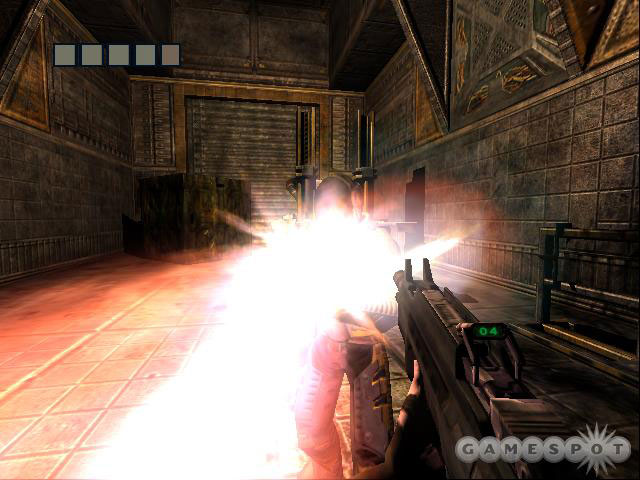
So here's what fascinated me about The Chronicles of Riddick in the first place. Both those movies I just mentioned were quite successful and fairly well received, especially the former--yet Vin Diesel turned down opportunities to star in both their sequels but agreed to star in the sequel to little-known Pitch Black, as well as the video game that would preempt its release. I've never met Vin Diesel, and I have no idea what he's actually like, and I can only speculate on what kind of a thought process might have led a popular action movie star to turn down a couple of surefire movie deals while still making time to personally work on a video game project. But, hell...that actually sounds pretty cool of him.
Sure enough, the game comes across as a real labor of love (on the part of a huge number of people, actually--it's no small-time production). This is no quick cash-in. No, the upcoming movie needs this game's success. You know why? Because it's up against high-profile movies like Troy and Shrek 2 and The Day After Tomorrow. And you know what? I have no plans to see those movies in theaters--but I'm definitely going to see The Chronicles of Riddick when it opens. I can't wait for it. I'm anxious for it, in fact. I liked Pitch Black a lot, and I love the new game, but part of what makes these things good is that they're uncompromisingly harsh. The upcoming movie is rated PG-13, though, which should make for a pretty strange contrast coming from a game that's filled with mature themes and lots of graphic violence. The point is, though, I'll see it no matter what. I want to know how this story progresses. I'm hooked.
The sequence of events I went through with The Chronicles of Riddick probably won't be uncommon. It's no coincidence that the game is the prequel rather than a follow-up to Pitch Black, which is a relatively obscure sci-fi horror movie that's just been reissued as a special-edition DVD--a little more than a week before The Chronicles of Riddick, the new movie, hits theaters. This is all perfect timing for people like me. We'll play The Chronicles of Riddick and absolutely get blown away by how good it is, and we'll also grow to like the game's main character in the process. So we'll naturally check out Pitch Black, which is the movie sequel to the game. And then we of course won't want to miss the sequel to that movie when it hits theaters, since that movie is good enough to have suddenly inspired these follow-ups.
I stand in awe of the creative strategy and business strategy that made this sequence of events possible. I also stand in awe of how, for the first time ever, a video game has made me really look forward to going to the movies--something I haven't cared all that much about for a long time.
| Bob Colayco Associate Editor |
Give Me Dedicated Servers or Give Me Death
In the interest of full disclosure, I'll go ahead and say it up front: I generally prefer to play first-person shooters on the PC. Mouse and keyboard control is faster and more precise than a controller, period. But this article isn't about the merits of using a mouse and keyboard versus the comfort of lounging on your couch with a controller in your hands; it's about scale. And right now console shooters are falling far behind in scale compared to what the PC can offer.
Both Sony and Microsoft have been upping the ante in the online space, vying for leadership. Electronic Arts' decision to finally kiss and make up with Microsoft dealt somewhat of a blow to Sony, who has reaped the benefits of Madden online exclusivity for a few years now. But despite the popularity of console sports games, and PC real-time strategy and MMORPGs, it's the first-person shooters that will always carry the mantle for online gaming. It's no accident that Counter-Strike is the most popular online game on the PC, and that Rainbow Six 3 is the most-played game on Xbox Live. That being the case, Sony and Microsoft should both start thinking long and hard about their online strategy going into the next hardware cycle.
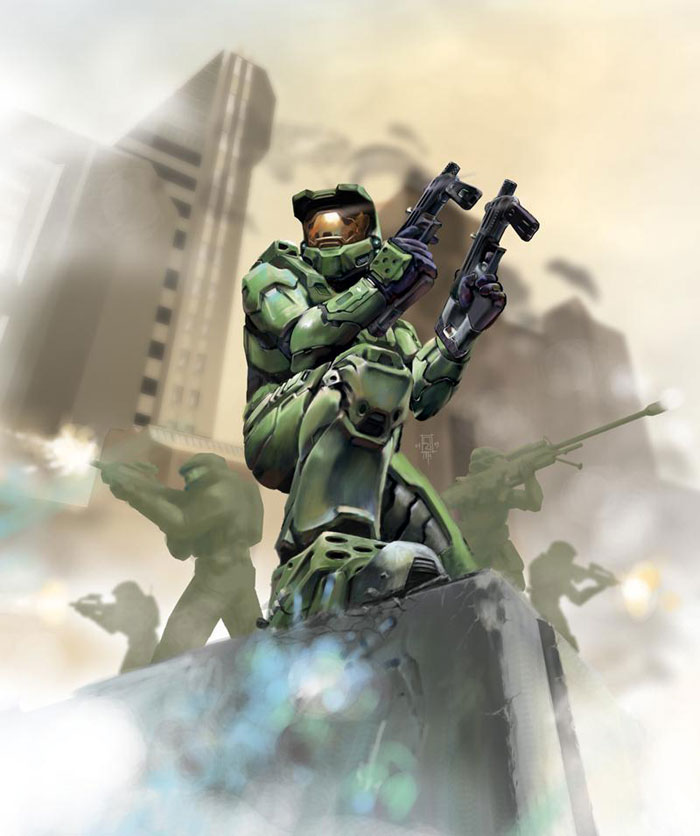
Let's consider the top upcoming shooters on both the PS2 and the Xbox: Killzone and Halo 2. People have seen the screenshots and read the hands-on previews, and now they're excited about what these games will bring to the table. But the cold, hard fact is that these games will only offer a maximum of 12- and 16-player online multiplayer, respectively. In other words, if you can find a good nearby server, you'll be playing a game that isn't fundamentally different than what we've been playing for about eight years on the PC in Quake 1. Oh, but there are vehicles in Halo 2, you say? OK, then that takes us to the merely six-year-old Starsiege Tribes on PC, which did vehicles--with 32 simultaneous players.
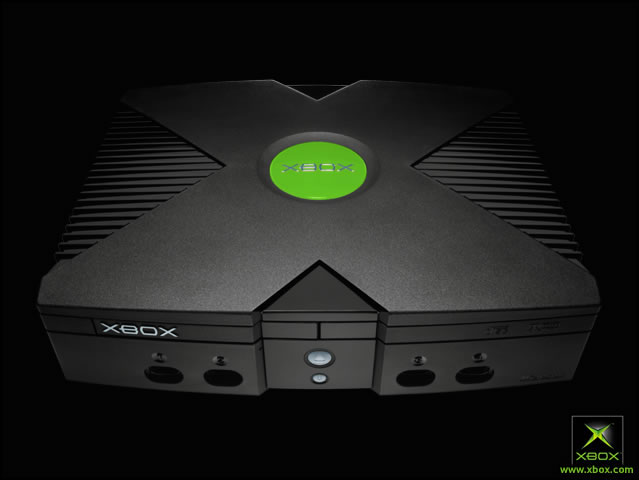
Now let's contrast those offerings with what's available today and what's in the pipe on the PC. Battlefield 1942 already offers 64-player multiplayer. Later this month, Novalogic will ship Joint Operations: Typhoon Rising, a military-themed FPS game that will allow up to 150 players in a single game. Reportedly, games with upwards of 200 players have been done during beta-testing. Meanwhile, EA has promised that the upcoming Battlefield 2, currently scheduled to ship in the first part of 2005, will have more than 100 simultaneous players. In other words, PC FPS games are supporting more players per game than consoles by an entire order of magnitude. The sheer size of the maps for Joint Operations and Battlefield 2 could potentially make any console FPS match feel like a shoot-out in a phone booth.
The bottom line is that console games need dedicated servers. As it stands today, only individual Xboxes are serving matches while simultaneously allowing the host to play. You simply cannot run a 24- or 32-player game with just a 733MHz processor and 64MB of system RAM available, hooked up to a potentially flaky cable or DSL line. And let's not even get into the PS2's hardware and what it can reliably serve. The reason PC games can handle so many simultaneous players is because publishers release dedicated server software. Server administrators around the world then load the popular game server software into their uberpowerful Pentium Xeon or 64-bit Opteron machines with gigabytes of RAM, hooked directly into fat T1 or T3 pipes (many of these boxes run multiple game servers at once). The bigger publishers often run their own fleet of servers just to provide a minimum number of reliable playgrounds, but most of a given game's servers are maintained by its own community. The more popular and reliably run independent servers even end up having their own subcommunities develop around them as regulars get to know one another and compare stats and scores.
Certainly, it's too late for this generation of console hardware, but with new consoles on the horizon, would it be too far fetched to see MS selling rack- mounted Xbox 2 servers with a beefier CPU and added RAM, for the purpose of hosting Xbox Live games? Would Microsoft run its own fleet of dedicated servers for the most popular games? Perhaps the push for consolidating Xbox and PC game development on the XNA platform could fix the problem also, by allowing Xbox server software to be run on regular Windows NT servers. Whatever the case, it would be a very sad thing if Halo 3 was limited to 16 or 24 players, while PC gamers could blast away at 150 or 200 of their closest friends in another game.
| Greg Mueller Intern |
Look Ma, I made it to E3!
While standing in line to get a press pass and gathering my wits for the day ahead, a freelance journalist behind me asked who I worked for and how many E3s I had been to. After I explained myself, he said, "Man, you are going to your first E3 as media? That's rough." His statements echoed warnings and forebodings I had been hearing for weeks prior to the event, but it was only then that it began to sink in that I was actually going to be at E3 2004. Despite all those warnings, I still had no idea what was in store for the next three days. Although I didn't face the hectic schedules and deadlines of the editorial staff, I knew what my job was and I was so focused on my own tasks that I didn't think of why everyone else was there. It was not until the show was over that I realized everyone at E3 was there to represent an industry of people like me who fell in love with their Atari or NES a couple of decades ago and somehow were lucky enough to turn their passion into a paying job. As the show closed and we left the convention center one last time, I chalked my first E3 up as a personal milestone, an affirmation, and an exciting glimpse of things to come.
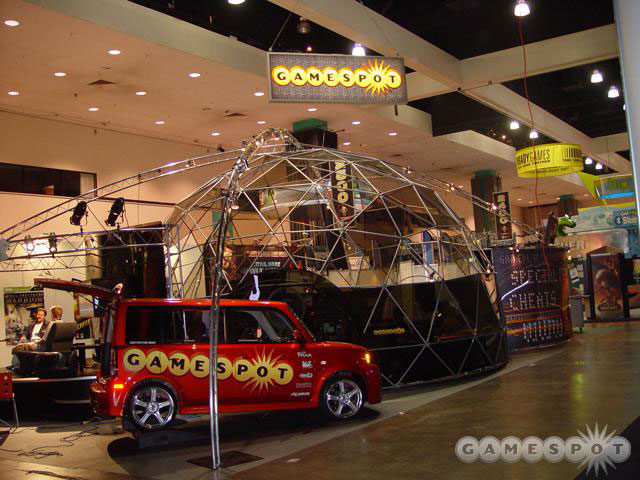
I have only been working in the video game industry for a little more than four months, but within that short time I have been amazed at just how sophisticated this industry has become. I do not mean sophisticated in terms of technology (although that's readily apparent), I mean sophisticated in terms of organization, reach, and influence. E3 itself recently won an award for the trade show with the most buying power. That is a pretty major accomplishment considering that there are many trades out there and many shows to have for them. One of the first things that took me aback when I stepped onto the show floor was the sheer size of the place. Everything was massive--from screens projecting game demos to the radical signage displayed everywhere. I kept thinking how amazing it was that in just the three days of E3, the larger companies must spend about ten times that of the entire budget of some of my favorite classic video games. Then I wondered, why? The show is, after all, closed to the public, and surely buyers and members of the media can't be swayed simply by who has the biggest video screen, loudest music, or the coolest way of incorporating oversized props into the design of the booth. It really is a lot to take in, and whenever I was not in the booth working or listening to the GameSpot editors talk about the cool video games they got to play, I wandered around the halls in a stupor, absorbing everything to contemplate later.
Then, on the third day at about noon my reverie was shattered when I realized the show was nearly over and I hadn't played a single game. How could I go home and tell my friends that I made the pilgrimage but forgot to go to church? So I ran around the show for awhile trying to find something to play. Of course, all the big games were crowded, so I spent some time with some smaller but still significant titles like Mario Pinball and Tales of Symphonia and Ace Combat 5. The games were interesting but I had a hard time focusing on the game I was playing when there were five other games within fifteen feet of me, all new and different. I gave up trying to play everything and just contented myself with watching other people play the games as I walked by them. For me, just observing the spectacle from within was the most fun and interesting part of E3.
To be honest, none of the games really blew my mind. Everything looked good, but nothing was particularly astounding. This is exemplified by the fact that most of the industry publications have chosen different games for their "Best of E3" awards. The companies did a great job of making their games look good, and the competition was tight. However, that does not really matter. This was a great E3 regardless of the new handhelds, Sega's huge Matrix announcement, and which porn stars made appearances. This was a great E3 because it showed more than ever the vitality and vivaciousness of this industry at a time when the rest of the entertainment media is grasping at straws to get the attention of the public. E3 is not just about what games will be coming out this year or the next; it is about making sure the rest of world knows that video games are to be taken seriously as art, entertainment, and business. The message is getting across, and as a gamer I took comfort in the crowded halls, bright lights, blaring music, and the audaciousness of the 2004 Electronic Entertainment Expo--and I can't wait until next year.
| Tyler Winegarner Associate Producer, GameSpot Live |
Layers of Abstraction
Gaming technology is pretty amazing these days. I remember looking at the screenshot of Batman for the NES, which showed full color stills from the Tim Burton film with which it was released in conjunction. The screens themselves were doctored, and nothing of the sort was in the final release game. I just never thought we'd see technology like that in games. But looking at titles like Chronicles of Riddick, clearly I was wrong, and it was for the better. And it's not just the visuals, either. The immersion is getting deeper and deeper, providing a more true-to-life (or true-to-fantasy, if that's your bag) sort of experience. What I'm saying is what you already know--that games are deeper than they've ever been before, providing experiences to players that they've never had.
I've had the tendency on more than one occasion to overanalyze things, and I often find myself examining gaming's role as an entertainment medium. When all of my other peers were jumping out of their seats in excitement about Top Spin, I just couldn't warm up to it. At the time I held an ethic in my mind that gaming entertains folks by providing an experience that would either be too dangerous for most players to partake in, too fantastical to exist, too expensive to be within their means, or rife with too many regrettable consequences. The "forbidden fruit" of life, if you will. Top Spin provided none of these things to me, and as such, I just wasn't all that interested. For a little bit more than what the game disc cost, I could get a cheap racket and some tennis balls, head to a local court, and play some tennis. It would have a fantastic interface, the graphics would be great, and it would provide a whole lot of replay value.
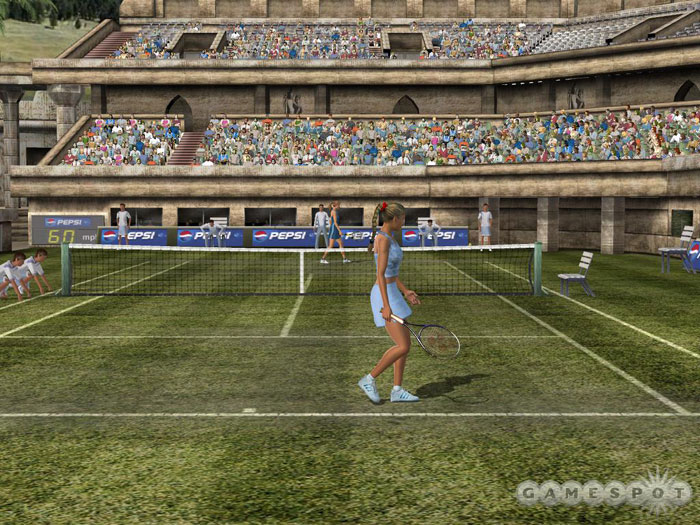
Of course, every time I think along these lines I have a tendency to act as my own devil's advocate. In this case, as games become more and more immersive as a life simulation, I wonder if this is the proper role of a video game. Ultimately, we play games because there's something that's fun to interact with on the screen. As we manipulate the controller, the image changes on the screen, sounds are emitted, the music changes, and perhaps we get some sort of tactile response from the rumble feature of modern controllers--this is the heart of interactive audiovisual entertainment. Give the player a character to identify with and let him or her enjoy the experience through the presentation of the game. Yet, oftentimes I wonder just how abstract a game can be before it turns players off. Sony Computer Entertainment America's rhythm games Frequency and Amplitude are fine examples of where this can go. If you try to apply a terse comprehension of what you are seeing on the screen, you'd be lost: So you're in a space ship, shooting lasers at little gems, and these unlock music tracks? Sure, whatever, guy. But if you experience it by sitting down and actually playing it, you would see what the designers were actually intending: A simplified experience of playing a number of different instruments that make up a song, offering a very tactile and interactive experience of creating music.
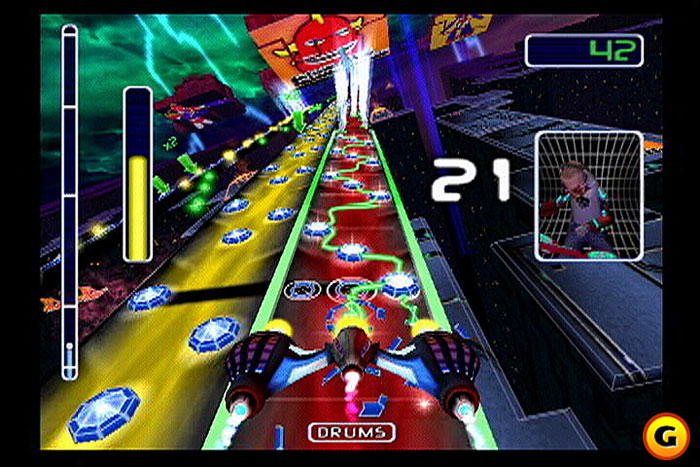
Gaming of this sort may not be the most accessible to the vast gaming market, or indeed, players just might not be interested in it in the slightest. But offering the firsthand tactile experience of playing with something will sometimes captivate more than it would drive away. I remember many years ago I attended the Siggraph Graphics conference. One of the sideshow exhibits at the expo was an "emerging technology" museum. Featured there was a pool of ferrous metallic fluid. Surrounding the pool were strong magnets that could pull the fluid into varying shapes, and people could interact with the forces of these magnets by sound. Now imagine a bunch of strangers talking, yelling, singing, and whispering to what looked like a puddle of crude oil, watching it ripple and dance, stand at attention, even jump or hang from the ceiling. Captivating interactive entertainment? You bet. I saw these people playing with this stuff for hours.

Is this the future of gaming? Probably not, but if anything is evidenced by some of the new technologies we've seen at E3 2004, from the Nintendo DS to titles like Katamari Damacy or Dog's Life, it's that there's plenty of innovation left in interactive entertainment--not only in providing gamers with experiences of the "forbidden fruit" of life, but also providing them with experiences they never knew they wanted in the first place.
| Ben Coello Renegade |
Ben's Amateurish Musings on What's It Like to Be at GameSpot
Hello there, you avid readers of GameSpotting. My name is Ben, and I am this week's guest editor. Since I recently had this opportunity to editorialize sprung upon me, I feel as though I am at a loss for words, which is exacerbated by the fact that I have never taken the time in my life to form a clear opinion of my own, because I prefer to let large conglomerates make decisions for me. (I do feel as though drinking Pepsi makes me part of a younger generation, though.)
As I write this, I sit in the GameSpot offices on a lazy Saturday afternoon. The place is almost entirely bereft of people, except for the film crew in the lobby that almost didn't let me into the office today. They're shooting a commercial of some kind, and I'm sure it will soon affect my opinion of whatever product it is that they are trying to sell. I'm taking a break from work to type, so perhaps what I type will suck, since I am going into this without any clear goal. I'm simply going to let my brain wander, and then I'll let it spill out through my fingers and onto the keyboard--and from there it'll go onto this electronic-writing thingy.
Why am I here? I'll tell you why. I'm making a documentary about GameSpot. Well, it's really a documentary about the GameSpot crew at E3. Yes, it will be a towering achievement that you will be able to see if you shell out the bucks to pick up the E3 DVD that GameSpot will soon be offering. Wanna know the mystical importance of Del Taco? Care to discover the awful secret behind R and R? I dare you to witness why SpongeBob SquarePants has got that smile on his face! It's all in the documentary. Plus, there's a bunch of guys bustin' their asses to bring you coverage on the biggest game show around, you unappreciative ingrates.
The reason I feel this documentary will be totally sweet is because in the two weeks since the E3 show ended, I've spent a majority of my nights crashed out on the GameSpot lounge's couch. It's a good couch for sleeping on, and I've slept on quite a few, so I know a good crashing-couch when I see one. One thing that makes a good crashing-couch is very soft armrests. Firstly, a nice, soft armrest makes for a nice, soft pillow. Secondly, I'm a tall guy, so there are few couches in the world that are long enough to prevent my feet from sticking over the end. Soft armrests also mean I wake up with my shins intact. I do have one issue with sleeping in the lounge, though. There's a security camera right above the couch. Staring into the dark abyss of that unblinking eye makes me wonder what the security guard is thinking as he watches me sleep for four to five hours. It also makes me wonder if they've got secret cameras behind the mirrors in the bathroom. And are they watching me as I brush my teeth at night?
This is also the reason why I'm not editing in only my underwear. As any editor will tell you, this is the best possible outfit for editing in. Well, come to think of if, I can't think of much that wouldn't be improved if we did it in our underwear. So here I am on a Saturday, wearing all my clothes and sitting at a computer, when I should be playing Frisbee instead. But don't you worry about that none... Being the professional that I am, I won't allow this to affect the outcome of the documentary.
There are also showers here at GameSpot HQ, but you don't even want to know about them. Trust me.
| Stephen Webster GuestSpotter |
Gaming With Purity
So, I am sitting in the Denton Public Library, North Branch, just checking my e-mail and such before I go home to continue moving my belongings to my new place. Lo and behold, there is a boy sitting next to me who could not be more than six years old. He is playing what looks to be Mega Man X.
No, wait. He died.
OK, now he's playing Sonic the Hedgehog. I just have to say, if this is not proof that a good game is always a good game--technology be damned--then I do not know what is. This brings back so many fond memories. It's no wonder I'm not the only one out there who gets nostalgic while thinking about the games on which weeks of my life were invested as a child.
Now he is gone, both literally and metaphorically. The kid got up and left. (His mother called.) But for me, the ability to enjoy such technologically amazing games as Far Cry, Unreal Tournament 2004, and Splinter Cell Pandora Tomorrow comes from having grown up watching the technology evolve. As this edge continues to be pushed further, developers gain a better artistic sense of what can be done with the medium. More and more, so much emphasis is placed on what is presented visually as opposed to what is done within the bounds of what has been done before. So, when I say that "he is gone," I am also referring to a part of myself.
Last night, as I moved more belongings into a new house and stacked box after box in my car, I paused for a few minutes to play my Sega Master System. Or, my Sega BASE System, as it says on the box. (In fact, it still has a Target price tag on it marked $179.95.) I played Double Dragon for a bit and then moved on to Space Harrier. Finally, I got to Hang-On, and I could hardly take it anymore. My hands hurt from the controller, my eyes were squinting from the onscreen frame-flicker, and I was not entertained.
Finding this a problem, and considering how much of a pragmatist I am with games, I decided to test myself. Pulling out yet another box, I inspected my options and settled on a game of Excitebike.
Let me tell you something about Excitebike... As a boy of seven, I had easily accrued more than 200 hours of nothing but Excitebike. My friends played it, and the neighbors' kid, who I was always fighting with, played it. Come to think of it, the only time we weren't fighting was when he was getting schooled on one of my custom tracks. However, the fighting would resume shortly thereafter. Anyway... After 10 short minutes, I had turned it off, befuddled, annoyed, and contemplative.
I just wish that we could look at interactive entertainment as purely as the kid sitting next to me at the library did--not to mention the kid I used to be. Because, in that sense, not only are we preserving a form of art, but we are able to pass that affection for an ever-changing medium's history on to those we come in contact with, whoever they may be. These are more than just fun and games. This is the beginning of an artistic revolution that is growing and changing every day. If we do not preserve the history of this movement, who will? But then again, if the only history we have to speak of is available on the Game Boy Advance for $29.99 apiece, maybe it is not worth the price.
Stephen Webster is the Associate Editor of Binary Culture
Got a news tip or want to contact us directly? Email news@gamespot.com

Join the conversation